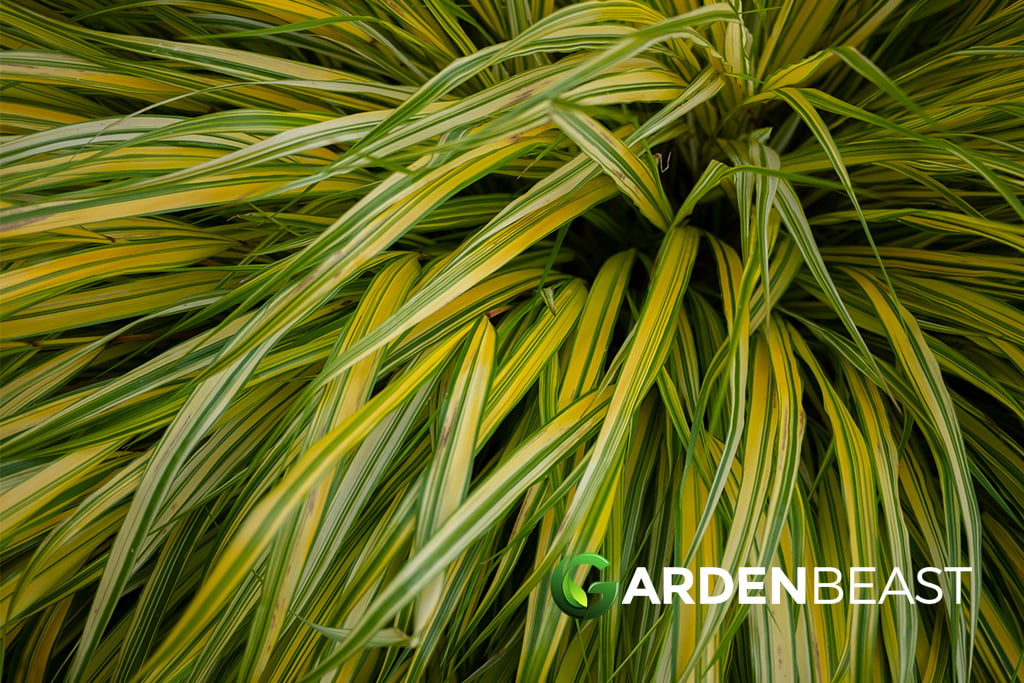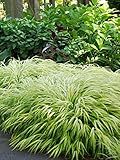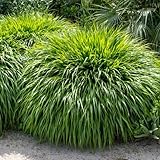Hakonechloa macra, commonly known as the Japanese forest grass or Hakone grass, is a tough, long-lived species of ornamental grasses in the Poaceae family.
This attractive plant is native to various regions of eastern Asia, with the largest diversity in Japan and China. It grows mostly in shady and moist woodland and mountain areas, such as wet rocky cliffs.
Although the Hakone grasses that are common in Europe are foliage-based species, they come along with numerous charming and colourful varieties. The most hypnotic cultivars of these plants include ‘All Gold’, ‘Aureola’, ‘Beni-Kaze’, ‘Fubuki’, ‘Nicolas’, ‘Sunny Delight’, and ‘Stripe It Rich’. Some of these cultivars are also more cold-hardy and sun-tolerant than the majority of varieties.
Now that you have plenty of options to choose from, it’s time to get more familiar with Hakone grasses. Keep reading to find out how easy to grow, care for, and even propagate these beauties are!
Watch Our Latest YouTube Video ...
Quick Facts
| Fact Category | Details |
|---|---|
| Common Name | Japanese forest grass or Hakone grass |
| Origin | Eastern Asia, primarily Japan and China |
| Preferred Habitat | Shady, moist woodlands and mountain areas |
| Popular Cultivars | ‘All Gold’, ‘Aureola’, ‘Beni-Kaze’, ‘Fubuki’, ‘Nicolas’, etc. |
| Height | 9 to 24 inches (23-61 cm) |
| Width | 20 to 24 inches (51-61 cm) |
| Foliage Colors | Tints of green, bright gold, or creamy variegated |
| Bloom Period | Late spring to early fall |
| USDA Zones | Most are hardy in USDA zones 5 to 9 |
| Special Features | Changes foliage colors across seasons, safe for pets & humans |
| Care Needs | Partial shade, cool temperatures, and moist, well-draining soil |
About Hakone Grass
- The true Hakone grass species with both ‘Alboaurea’ and ‘Aureola’ varieties have gained the well-known Royal Horticultural Society’s Award of Garden Merit.
- The Hakonechloa name of their genus comes from the words “Hakone”, which is the area from Japan where these plants grow naturally, and “chloa”, which means “grass”. Thus, the name translates to “grass from Japan”.
- Hakone grasses thrive in environments where they can receive some partial shade and cool temperatures. They are moisture-lovers that perform best in humus-rich, well-draining soils.
- In warmer climates, you must remove any dead leaves from Japanese forest grasses anytime between late fall and early spring. If you want to overwinter these plants, we suggest you leave the unhealthy foliage alone until next spring.
- Hakone grasses are extremely adaptable to a wide variety of landscaping and garden uses. They look gorgeous around trees, along border paths, in shaded patio areas, or as potted plants. Likewise, they are wonderful ground covers or accent plants.
- These ornamentals can make for great companions to other fabulous species of plants including Astilbes, Celosia, Columbine, Coral Bells, Great Masterwort, Plantain Lily, Morning Glory, and Toad Lily.
- Hakonechloa macra plants have no toxic effects on animals or humans if ingested or touched. You can safely grow these species around your furry friends or curious children.
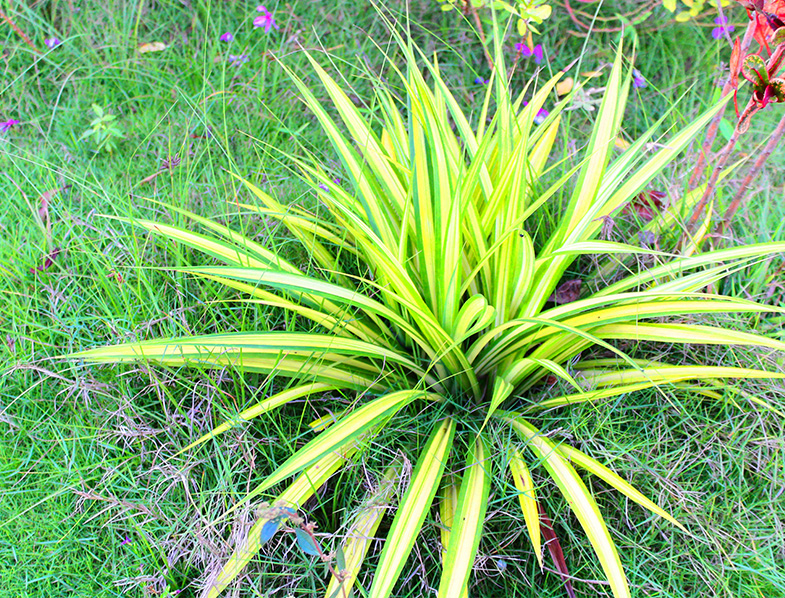
Hakone Grass Features: An Overview
- These plants belong to the Hakonechloa genus of bunch grasses or tussock grasses. This genus is monotypic, containing only the particular Hakonechloa macra species.
- Hakone grasses are rhizomatous perennials that can reach from 9 to 24 inches (23-61 cm) in height and 20 to 24 inches (51-61 cm) in width.
- They are clump-forming bunchgrasses that grow and spread at a pretty slow pace. These plants produce numerous thin, wiry stalks that usually cascade in an elegant, arching, loose, and rounded fountain shape.
- Their foliage consists of long, slender, lance-shaped, soft, and papery leaves that resemble many forms of bamboo species. When the wind blows, their leaves come with a distinctive rustling sound.
- The leaves of these grasses are very flexible and can show up in various tints of green, bright gold, or creamy variegated from spring through summer. In autumn, the foliage turns into exquisite copper-orange, red, and purple shades.
- Hakone grasses can bloom from late spring to early fall. Their flowers are mostly insignificant comparing with their foliage. They can exhibit different hues of white, yellow, cream, gold, red, purple, and brown.
Growing Hakone Grass
In general, Hakone grasses will have the time of their life in an environment that mimics their natural habitat. Because of this, you have to pay attention to their particular demands if you want to be the coolest owner out there. And, believe us, having these plants around and pampering them is much easier than you might expect!
Unlike most species of grasses, Japanese forest grasses grow at their best in partially shaded areas. Make sure you grow these plants in a location where they can receive plenty of partial shade daily. If you live in a region with cooler climates, they can usually withstand more sunlight. However, partial shade exposure will keep the foliage of your plants in good shape.
When it comes to temperature and humidity, Hakone grasses prefer cool and moist conditions. With proper care, these plants can also do just fine in regions with warmer climates. Still, extreme conditions like heat or frost may kill your beloved grasses with time. Although some varieties can tolerate winter conditions in hardiness zone 4, most cultivars are typically hardy in USDA zones 5 to 9.
Since Hakone grasses are generally resilient to pest infestations and fungal diseases, you will not encounter any problems along the way. But if these plants experience overly wet conditions for prolonged periods, crown and root rot may occur. To avoid these issues, do not plant your grasses too deep in the soil and adopt a suitable watering routine.
- PLEASE DO NOT ORDER IF YOU LIVE IN ONE OF THESE USDA RESTRICTED STATES: AK, AZ, CA, CO, ID, MT, NV, OR, UT, WA AND HI. Hardy in USDA zones 5-9.
- Part shade, full shade
- Long sword shaped golden leaves form graceful clumps growing about 12” in Height. Provides dramatic textural contrasts, especially when planted in drifts. Prefers moist, humus, well-drained soil. Plant 24" Apart
- When received, the plant will be in seasonal condition with appropriate foliage. If shipped between November 1st and March 1st, plant may be dormant and trimmed. Plant is fully rooted in the pot ready for immediate planting
- Deer-leerious (highly deer resistant plants)
- Hakonechloa Grass Live Plant, Japanese Forest Grass Plants, Perennial Hakonechloa Grass Plants Live Potted, Live Ornamental Grass Starter Plants in 2.5 Inch Pot, Appx 4 to 6 Inch Tall
Last update on 2024-09-22 / Affiliate links / Images from Amazon Product Advertising API
Planting Hakone Grass
Whether you want to grow your Hakone grasses outdoors or indoors, planting time is very important. These plants go dormant during the winter months, so they must have enough time to settle in their new environment until then. Due to this, we recommend you plant your alluring grasses in spring or early autumn. Also, you should avoid planting them during dry heat.
In terms of growing medium, Japanese forest grasses are not picky at all. These plants perform well if you plant them in any moist soil that also comes with excellent drainage. For optimal growth, look for substrates that contain a good amount of humus and other organic matter. In case the soil is too dense, you can amend it with peat moss or compost right before planting your grasses.
Hakone grasses are big lovers of nutrients, so they require regular fertilizing to maintain their vigor and splendour. Feed your plants with a nitrogen-based liquid fertilizer once every year after the first new growth shows up, usually in spring. If you do not want to fertilize your plants, you can apply some organic mulch in their soil yearly in early spring.
Dwarf Hakone grass cultivars can also make for great indoor ornamentals in pots. Make sure you plant your grasses in containers that have drainage holes at the bottom. Potted specimens are generally very low-demanding if you grow them in proper conditions. Moreover, they grow at a very slow pace, so they will not outgrow their pots nor need repotting for a very long time, if ever.
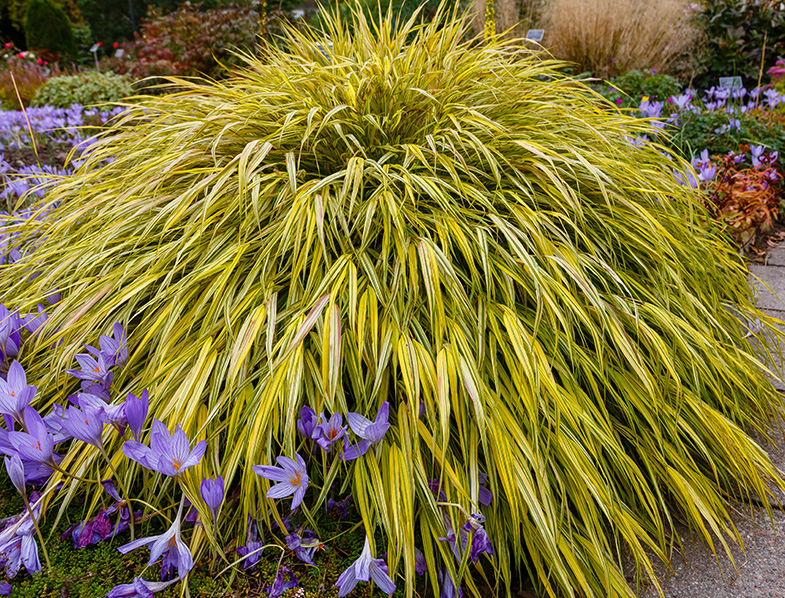
Watering Hakone Grass
In their native habitat, Hakone grasses receive lots of moisture all year round. These buddies thrive in constantly moist soil and will not appreciate nor enjoy arid conditions. If you want your plants to grow healthy and happy, make sure you provide them with water regularly to maintain their soil damp.
In regions with frequent rainfalls, your Japanese forest grasses can do well without any supplemental irrigation. They will get the amount of moisture needed from rainwater, making them super friendly start-ups for beginners or forgetful gardeners.
In hot and dry climates, however, these plants will require water more often than usual. The most common signs of under-watering are wilting or brown leaves. If you notice this kind of change on your Hakone grasses, do not panic! All you have to do is spoiling them with a nice, deep soaking and they will get back to life pretty quickly.
The watering technique is also very important for Hakone grasses. It is wise to water your plants only at the soil level without touching their leaves in the process. In general, some issues like foliage rot may occur when water stays on the leaves for too long.
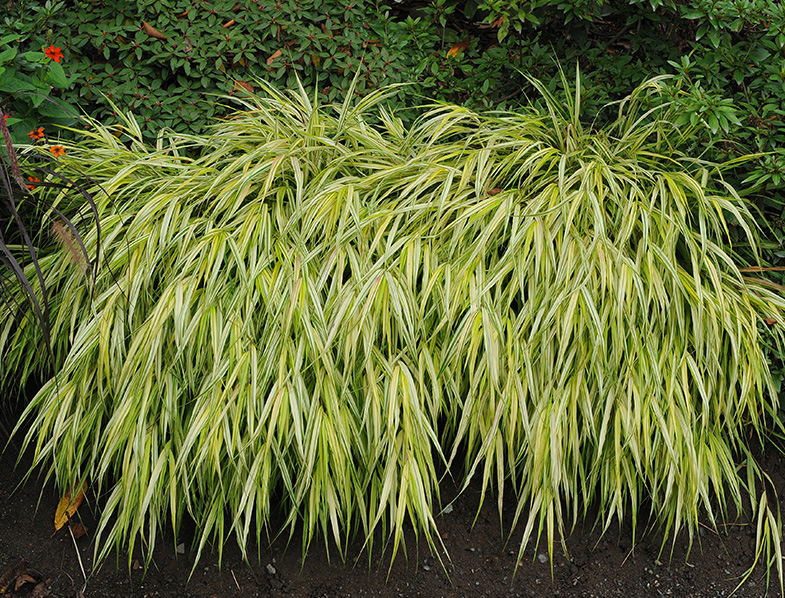
Propagating Hakone Grass
Thanks to their slow-growing habit, Hakone grasses do not require division for many years. However, you can always divide these stunning plants to obtain more for your garden landscape. This process is very simple, exciting, and shows nice results much faster than you might think. But you cannot know this for real until you are doing it yourself!
These companions respond best to division at the beginning of their active growing season, usually in spring. First things first, go on and find a good spade to dig your Japanese forest grasses out of the soil. After this step, you must divide their rhizomes into as many tiny sections as you want. For proper growth, make sure each section has at least one stalk attached to it.
Once you have the baby rhizomes, you can transplant them absolutely anywhere you want to. We all know that everything is better when shared with our beloved ones, so why not surprise them with a lovely gift? Go on and plant some of those Hakone grass sections in pots to gift them to your grass-lover family members or friends!
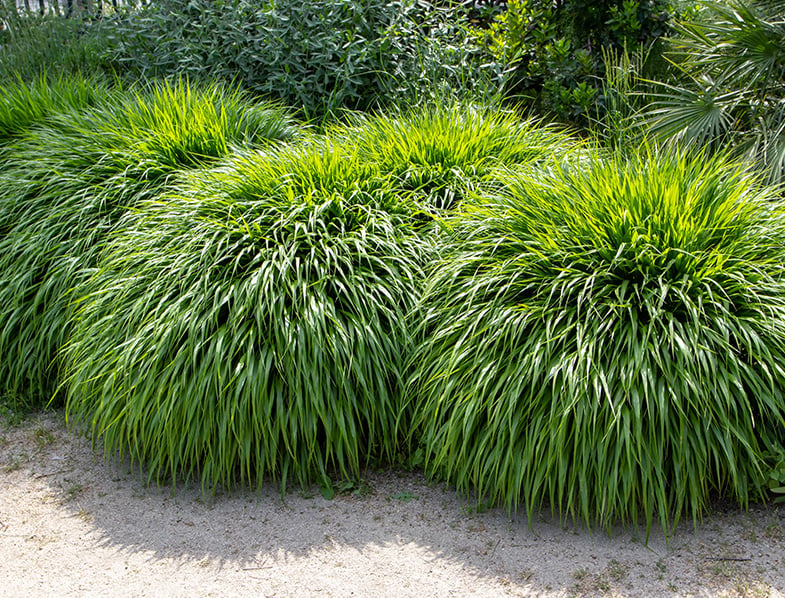
Conclusion
With their superb appearance and easy-going nature, Hakone grasses are a must-have in every respectable collector’s garden or home. These plants bring ornamental interest nearly all year round, changing their foliage into various hypnotic colors from one season to another. And with so many cultivars to choose from, you will surely find at least one specimen to fit your garden perfectly!
Hakone Grass FAQs
How do you grow Hakone grass?
Plant Hakone grass during spring or early autumn in humus-rich, well-draining soil. Ensure the plant receives partial shade, especially in warmer regions. It thrives in environments that mimic its natural habitat—shady, moist woodlands and mountain areas.
How fast does Hakone grass grow?
Hakone grass grows and spreads at a relatively slow pace. Being clump-forming bunchgrasses, they gradually extend, forming a rounded fountain shape over time.
How do you care for Hakone grass?
Care involves providing the plant with partial shade and cool temperatures. The soil should remain consistently moist. Remove any dead leaves between late fall and early spring. In warmer climates, be cautious about the plant’s water needs, ensuring it remains hydrated but not waterlogged to prevent root rot.
Does Hakone grass like sun or shade?
Hakone grass prefers partially shaded areas. In cooler climates, they can tolerate more sunlight, but partial shade ensures that the foliage remains healthy.
Does Hakone grass spread?
Yes, Hakone grass spreads, but it does so slowly. It forms clumps and expands over time, making it a manageable plant in garden landscapes.
Does Hakone grass need fertilizer?
Hakone grass benefits from fertilization. Feeding with a nitrogen-based liquid fertilizer once a year, typically in the spring after the first new growth appears, helps maintain its vigor. If you choose not to use fertilizer, applying organic mulch to the soil each spring is a suitable alternative.
